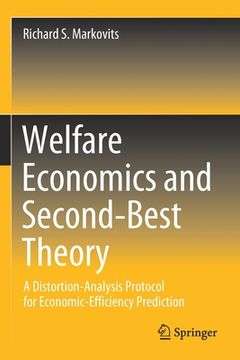Compartir
Welfare Economics and Second-Best Theory: A Distortion-Analysis Protocol for Economic-Efficiency Prediction (en Inglés)
Richard S. Markovits
(Autor)
·
Springer
· Tapa Blanda
Welfare Economics and Second-Best Theory: A Distortion-Analysis Protocol for Economic-Efficiency Prediction (en Inglés) - Markovits, Richard S.
$ 92.82
$ 142.80
Ahorras: $ 49.98
Elige la lista en la que quieres agregar tu producto o crea una nueva lista
✓ Producto agregado correctamente a la lista de deseos.
Ir a Mis Listas
Origen: Estados Unidos
(Costos de importación incluídos en el precio)
Se enviará desde nuestra bodega entre el
Jueves 18 de Julio y el
Lunes 29 de Julio.
Lo recibirás en cualquier lugar de Ecuador entre 1 y 3 días hábiles luego del envío.
Reseña del libro "Welfare Economics and Second-Best Theory: A Distortion-Analysis Protocol for Economic-Efficiency Prediction (en Inglés)"
This book examines the implications of The General Theory of Second Best for analyzing the economic efficiency of non-government conduct or government policies in an economically efficient way. It develops and legitimates an economically efficient economic-efficiency-analysis protocol with three unique characteristics: First, the protocol focuses separately on each of a wide variety of categories of economic inefficiency, many of which conventional analyses ignore. Second, it analyzes the impact of conduct or policies on each of these categories of economic inefficiency, primarily by predicting the respective conduct's/policy's impact on the distortion that the economy's various Pareto imperfections generate in the profits yielded by the resource allocations associated with the individual categories of economic inefficiency--i.e., on the difference between their profitability and economic efficiency. And third, it is third-best--i.e., it instructs the analyst toexecute a theoretical or empirical research project if and only if the economic-efficiency gains the project is expected to generate by increasing the accuracy of economic-efficiency conclusions exceed the predicted allocative cost of its execution and public financing. The book also uses the protocol to analyze the economic efficiency of specific policies so as to illustrate both how it differs from the protocols that most applied welfare economists continue to use and how its conclusions differ from those produced by standard analysis.
- 0% (0)
- 0% (0)
- 0% (0)
- 0% (0)
- 0% (0)
Todos los libros de nuestro catálogo son Originales.
El libro está escrito en Inglés.
La encuadernación de esta edición es Tapa Blanda.
✓ Producto agregado correctamente al carro, Ir a Pagar.

